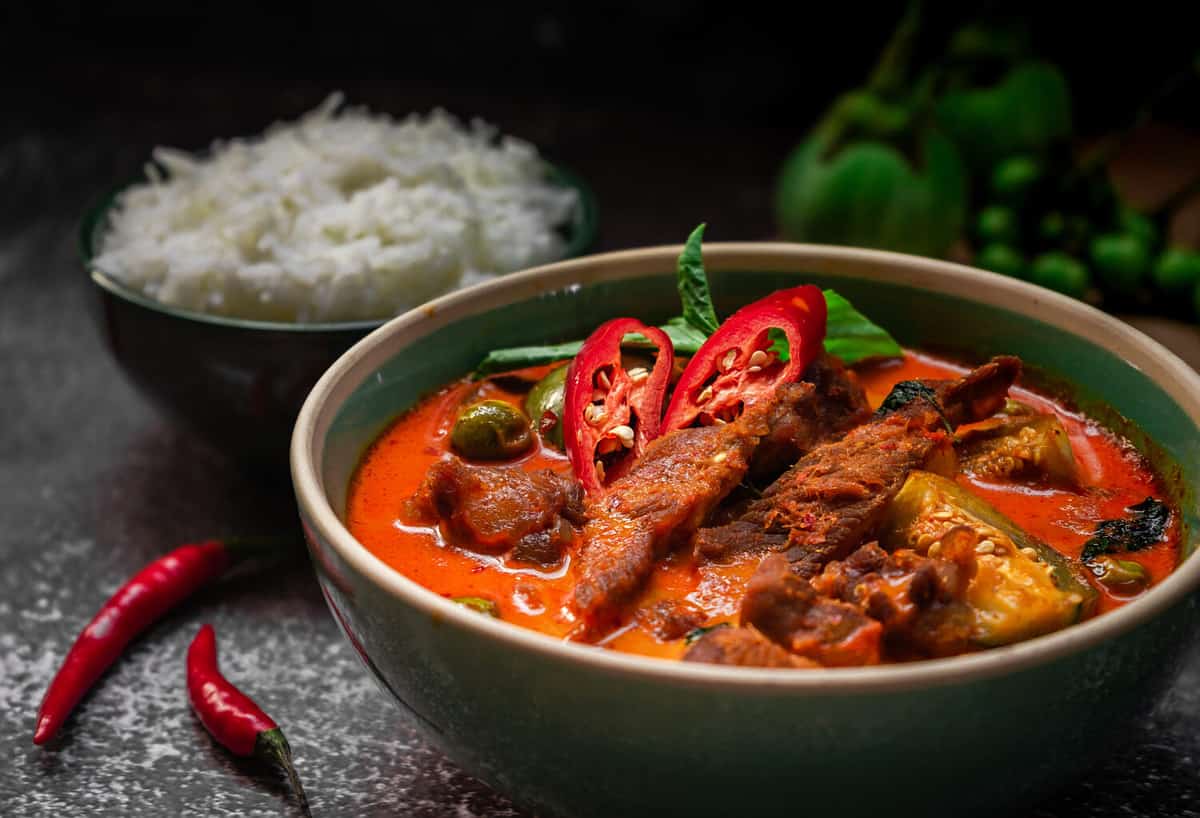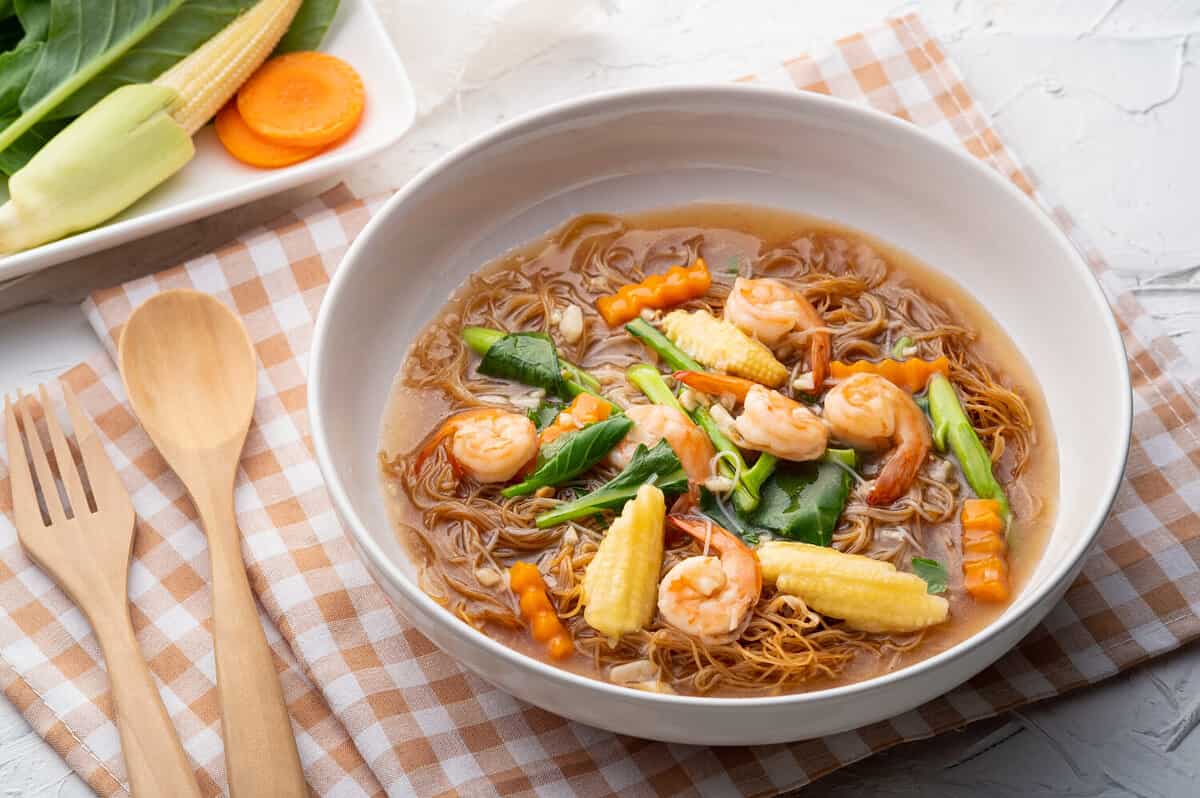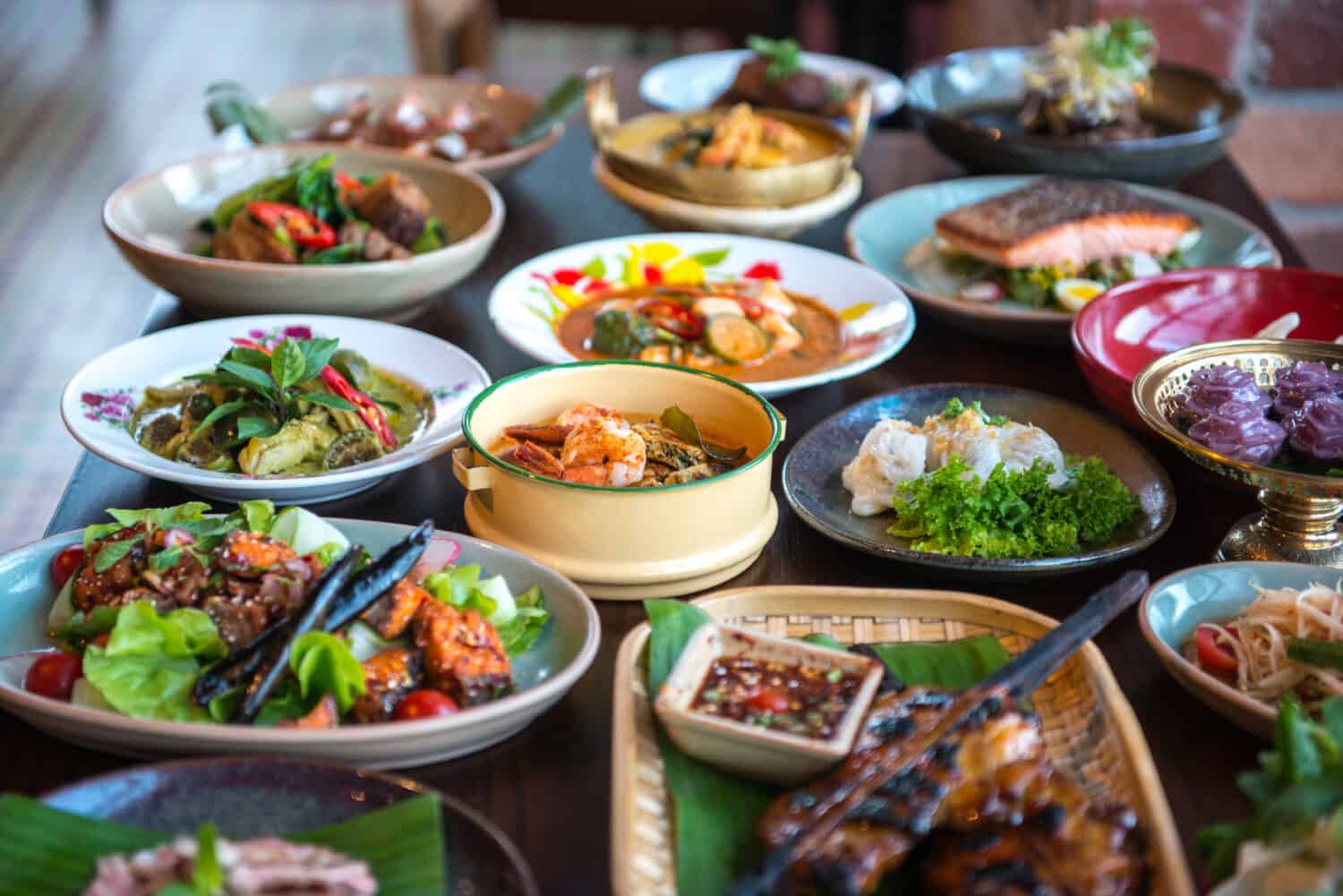Ahan Thai, Thailand's national cuisine, is well known for its fresh, bright ingredients, fragrant aroma, and spicy flavor. David Thompson, an Australian chef, who specializes in Thai food, says Thai cooking is all about utilizing different ingredients to create an exquisite final dish. Thai food has become popular worldwide and is often regarded as healthy; however, some disagree. In this article, we will discuss the history, nutritional values, health benefits, common ingredients, best and worst dishes, and discover whether Thai food is healthy.

©Meowsom3/Shutterstock.com
The History of Thai Food
Thailand’s neighboring countries — Indonesia, Cambodia, Malaysia, Laos, India, and Myanmar — have influenced one another in their different culinary traditions for many centuries. In the book “Indian’s Benevolence to Thailand,” Thai monk Venerable Buddhadasa Bhikku claims that Indian cuisine influenced Thai cuisine. Indians had taught the Thai people how to incorporate spices and use various techniques in their cuisine. Furthermore, Thais also learned how to make herbal medicine from the Indians. Some of these plants from India include rose chestnut, sarabhi, or phikun. To add to that, during the 16th or 17th century the Americans introduced the chili pepper to Thai cuisine. Today, rice and chili peppers are two of the most essential ingredients.
Traditionally, there are four Thai cuisine categories:
- Steaming, stir-frying, and deep-frying was introduced through Chinese cuisine.
- Tom: which is boiled dished
- Kaeng: known as curries
- Yam: these are spicy salads

©Kritchai7752/Shutterstock.com
World’s 50 Best Foods Survey
In an online poll in 2017, there were 7 Thai meals listed on the World's 50 Best Foods. These dishes were:
- Tom Yam Kung ranked 4th. This is a soup that includes broth, lemongrass, kaffir, lime leaves, galangal, lime juice, fish sauce, and chili peppers.
- Pad Thai ranked 5th. The main ingredients include rice noodles, eggs, tofu, tamarind juice, sugar, fish sauce, fresh shrimp, dried shrimp, bean sprouts, garlic or onions, red chili pepper, lime, and peanuts.
- Som Tam ranked 6th. This is a green papaya salad often served with rice on the side. Chili, brined crab, lime, hog plum, yardlong beans, and pla ra are ingredients. Instead of using green papaya as the main ingredient, variations include green unripe, bananas, cucumber, green unripe mango, banana flowers, pomelo, coconut rice, mixed fruit, mu yo sausage, or hard unripe santol.
- Massaman Curry ranked 10th in 2017 and 1st in 2018. This mild spicy curry is rich and full of flavor. Chicken is the most common protein added. However, goat, duck, venison, mutton, and beef are variations. Pork is rarely used because it is not eaten by observant Thai Muslims. To further add vegans and vegetarians have created their version by substituting shrimp paste or fish sauce for tofu. Common spices used in a massaman curry are nutmeg, cumin, star anise, bay leaves, cinnamon, cardamom, and cloves. However, most of the ingredients are used in Indian cuisine and Thai residents have added chili peppers, lemongrass, shallots, cashmere nuts, white pepper, garlic, potatoes, and galangal to increase the flavor. To give this dish its rich flavor coconut milk is added as the base in most Thai curries.
- Green curry ranked 19th. This delicious cream curry is served hot and made with coconut milk, green curry paste, fish sauce, Thai basil, kaffir lime leaves and palm sugar. It is often served with a roti on the side. Main proteins include fish balls, meat, or eggplant.
- Thai fried rice ranked 24th. There are different types of fried rice. Thai rice is commonly stir-fried rice with garnishings such as green onion, tomato, and cucumber and is typically served on a bed of lettuce. Furthermore, This dish is different from Chinese rice which commonly uses long grain rice. Thai rice uses jasmine rice and normally contains crab, chicken, or shrimp as well as eggs, garlic, and onions. However, common seasoning usually includes soy sauce, fish sauce, and a spicy sauce made with Thai chilies that are sliced as well as lime and coriander.
- Finally, we have Nam tok mu ranked 36th. It is a type of Thai salad native to Laos which is to the Northeast of Thailand. It is made with thin slices of grilled pork covered with chili powder, fish sauce, lime herbs finely chopped chives, and roasted rice. It has a salty, sour, and spicy flavor and is not too expensive to make.
Common Ingredients in Thai Cusine and Their Benefits
There are 25 commonly used herbs and spices in Thai cuisine.
- Bai bua bok known as Centella asiatica: Commonly used in an iced drink. According to vivo and vitro studies, Centella asiatica has important health benefits like memory enhancement, wound healing, and antidiabetic, antioxidant, and neuroprotective properties.
- Bai toei known as screwpine leaves or Panda: This leaf smells sweet and is often used in desserts and sweet snacks. It is often used to stuff barbecued fish and is also wrapped around deep-fried chicken. It is believed to have medicinal benefits and contains alkaloids and glycosides which can treat skin problems and headaches.
- Protein 2.4%
- Fat 0.2%
- Carbohydrates 6.7%
- Phosphorus 17mg
- Iron 14.9mg
- Sodium 107.8mg
- Bai yanang known as Tiliacora triandra: The juice is extracted from the leaves and used in soups. This herb is used for treating fever, malaria, and diabetes.
- Kuichai known as Alium tuberosum Chinese chives: This herb has a garlic flavor and is often used in stir-fries it comes in yellow and green. Furthermore, it promotes good digestion and is used for treating intestinal parasites.
- Horapha known as Thai sweet basil: Is a sweet basil used in green and red curries. Thai basil contains vitamins A, C, and E and maintains healthy-looking skin.
- Kha known as Galangal: This herb has a perfume fragrance and is used in spicy soups and curries. It improves stomach problems and respiratory diseases.
- Khamin known as turmeric: Is a root that is used in curries and is known to have anticancer, antioxidant, and anti-inflammatory properties. In addition, research studies have found that turmeric may benefit, muscle soreness, arthritis, and degenerative eye conditions.
- Khing known as ginger: Can be served raw and is often used in stir-fried dishes and dips. It contains a decent amount of vitamin B6, magnesium, and manganese and supplies the body with 80 kilocalories of food energy.
- Krachai known as fingerroot: This root is used in fish curries and fish dishes. According to researchers, fingerroot possesses antibacterial, anticancer, and anti-allergic properties.
- Kaphrao is known as holy basil: This herb smells similar to clove and is believed to help reduce inflammation, stress, and anxiety and lower cholesterol and blood sugar in those who have diabetes.
The Next 10 Common Herbs
- Krathiam known as garlic: Garlic is often served fried cooked or raw and is used in many dishes, salads, and dips. It is believed that eating garlic may ward off the flu or a cough and that it is good for improving brain function and boosting immunity.
- Maenglak known as lemon basil: The leaves are used in curries and the seeds are used in sweet desserts and look similar to frog eggs when soaked in water. It is commonly used in stir-fries, soups, and stews. Lemon basil contains high levels of vitamin K which plays an important role in strengthening the bones.
- Phak chi known as coriander: These green leaves are often used as a garnish and are rich in vitamins A, C, and K calcium, and iron. Coriander may fight infections and improve skin health.
- Phak chi farang known as culantro: It is sometimes used as a substitute for coriander and is often found in curries and soups. It is a good source of vitamin A which helps maintain healthy organs. The leaves also have a good source of thiamin, iron, and riboflavin.
- Phak chi lao known as dill: Dill is used in curries and soups that do not have coconut milk. Dill promotes digestion and is a remedy for insomnia.
- Phak phai known as Vietnamese coriander: It is commonly used in soups and salads and can improve stomach pain, dandruff, and constipation.
- Phrik chi fa known as chili spur pepper: These are often added to curries as a vegetable and can help fight colds, flu, and fungal infections. It also eases migraines and improves the metabolism.
- Phrik khi nu known as bird’s eye chili: Is a small very hot chili with about 50,000-100,000 Scoville units.
- Phrik thai on known as fresh peppercorns: Thai dishes often contain fresh green peppercorns. Peppercorns help fight against arthritis and may prevent cardiovascular disease.
- Phrik khi nu suan known as garden mouse dropping chili: This is another small chili and even more spicy.
The Last 5 Common Herbs In Thai Food
- Phrik yuak, phrik wan known as bell pepper, sweet pepper, and wax pepper: These peppers have a mild flavor and can be stir-fried or deep-fried and stuffed with pork. These peppers are rich in vitamin A and help maintain good eyesight.
- Rak phak chi known as coriander root: Is often used in soups and curry pastes.
- Saranae is known as spearmint: It is often used in salads and sometimes to get rid of the muddy flavor of specific fish. Spearmint is high in antioxidants and improves digestion.
- Takhrai known as lemon grass: Is used in spicy soups, salads, and curries. Lemon grass relieves bloating and boosts oral health. Additionally, it is also used as a natural remedy for high blood pressure.
- Makrut known as makrut lime, kaffir lime, and Thai lime: Has a very strong fragrance to eliminate bacteria in the mouth you can rub the leaves on your teeth. It is also rich in calcium and vitamin C.
Is Thai Food Healthy?
While Thai food may seem nutritional with fresh vegetables and deliciously spicy, sweet, and sour flavors we need to remember that it is not all about the ingredients but also how it is prepared. Thai dishes usually have a good balance of fats, carbohydrates, and protein. They frequently include non-starchy veggies like tomatoes, peppers, and carrots that provide fiber vitamins, and minerals.
Additionally, there are some drawbacks to Thai cuisine — some meals are high in sodium with the added soy or fish sauce. This can lead to high blood pressure or other health problems. Some deep-fried dishes contain unhealthy fats and added sugar so they should eaten in moderation. Another thing to be mindful of is portion sizes, as Thai restaurants in America serve large portions which can lead to weight gain and diabetes.
Healthy Thai Dishes
- Summer rolls
- Papaya salad
- Chicken satay
- Tom yum soup
- Chicken larb
- Pad Thai
Unhealthy Thai Dishes
- Fried spring rolls
- Thai fried rice
- Green or red curry
- Massaman curry
- Thai Iced tea
- Crispy fish
Finally, Thai food can be full of vitamins and minerals that can benefit the body and there are healthier options you can choose from. By opting for healthier cooking methods and avoiding certain fats you can still enjoy the delicious taste of Thai food.
The image featured at the top of this post is ©Leelakajonkij/Shutterstock.com
